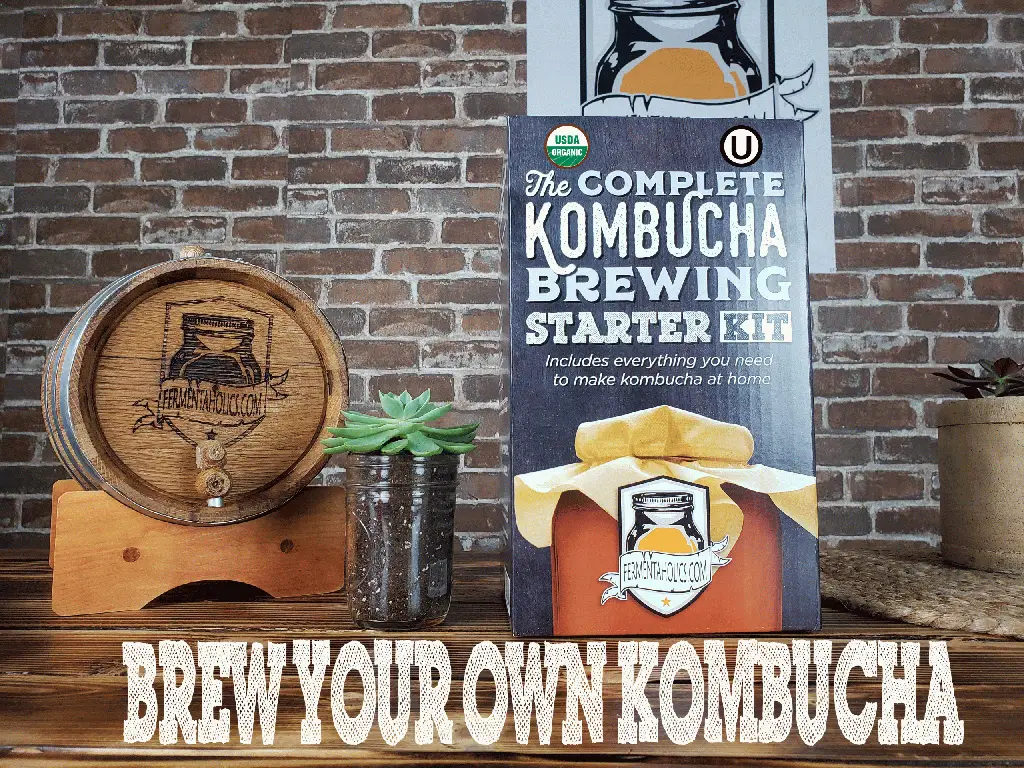

Two buzz words have officially collided: Keto and Kombucha. The ketogenic (or keto) diet is structured around a high fat, low carb philosophy and has become wildly popular. Those following a ketogenic diet have a strict number of carbs they can consume in one day. You can get “kicked out” of ketosis by going over. Can you drink kombucha and remain in ketosis? The answer is yes, if consumed in moderation.
Kombucha is fermented sweet tea. Asian, European, Japanese, and Russian cultures are known to have brewed kombucha for centuries. Despite its age, kombucha has remained somewhat under the radar, until now. The rise in popularity of probiotics and gut health has propelled kombucha into the spotlight. To read more about kombucha, see our article: What is kombucha?
Keto is short for ketogenic. A ketogenic diet is a very low-carb, high fat diet.
Starving your body of carbs forces it to start burning fat as fuel. Ketones are a byproduct of the fat breakdown that occurs in your liver (source). The presence of ketones is a way to measure if your body is metabolizing fat, or in a state of ketosis.
Your body will burn glucose (carbs) first if it is available, even if you’re in ketosis. This is how you get “kicked out”.
The kick-out threshold differs per individual, but the general guideline is to consume less than 20-50 net carbohydrates per day to remain in ketosis.

It depends! Not all kombucha is made equal.
Some carbs are inevitable because all kombucha starts with sweet tea. But how much? The SCOBY (symbiotic culture of bacteria and yeast) eats the majority of the sugar by the end of the fermentation. The exact amount leftover depends of various factors such as fermentation duration and temperature.
If purchasing kombucha at the store, you can simply read the labels and know exactly how many carbs and grams of sugar are in each serving. It seems that the range is between 6-12 carbs per 8oz serving of kombucha, depending on the brand and type. Even at 6 carbs, that is taking up quite a bit of your daily keto-allotment so shooting for 4oz might be the better option.
What if you wanted to brew your own kombucha?
The best way to ensure that your kombucha is low carb is to ferment is for a full 21-30 days. The yeast will continue to consume the sugars until the end of the fermentation, leaving you with less and less as time goes on.
The longer the fermentation goes, the stronger the kombucha gets. You don’t want to directly consume super mature kombucha because it is highly acidic and can possibly cause complications. (Read this post for more info on why kombucha tastes like vinegar) Instead–dilute the kombucha with selzter water! A lot of great sugar-free flavored soda water is available now which you can use to dilute and add flavor without going over your daily carb intake!
💡Pro Tip: Using different tea blends adds tons of flavor right from the beginning. Try blending rooibos tea or hibiscus tea in your regular tea blends to add a natural sweet flavor without any added sugar. Opt for half green and half hibiscus tea or half black and half rooibos!
The sugar provides the nutrients for the SCOBY during the fermentation. Using less sugar doesn’t necessarily translate to less sugar in the end. The SCOBY breaks sugar down into glucose and fructose. Any sugars leftover in the fermentation will be fructose, which is harder for the SCOBY to break down. Less sugar initially means that the SCOBY has less to convert into healthy nutrients for us. Instead, just opt for a longer fermentation.
Our article on what type of sugar to use for kombucha further explains the role sugar plays in the fermentation.
The purpose of doing a secondary fermentation is to flavor and carbonate your kombucha. You add fruit or sugar when you bottle your kombucha and let it ferment a little longer, allowing carbonation to build. The secondary fermentation is short, just 1-7 days so it’s safe to say some of the sugars will remain from the bottle conditioning.
What about artificial sweeteners? You can use artificial sweeteners to add flavor but they won’t work to build carbonation. The yeast do not recognize it as food because the chemical structure of the sugar molecules has been altered.
Opting for the flavored seltzer water approach seems to be the most practical way of going about consuming kombucha on keto. You get flavor and carbonation without adding any extra carbs.
You can drink kombucha on a ketogenic diet, with a few tweaks. The best way is to brew it yourself and opt for a long fermentation. The longer the fermentation, the more sugar gets consumed and the stronger the kombucha is. After that long fermentation, dilute the mature kombucha with flavored seltzer water (to lower the acidity) and add keto-friendly sweeteners to flavor!
If you are serious about remaining in ketosis, get yourself a ketone test kit. Everyone’s body is a little different so testing is the only way to be sure!

Yes, Kombucha can be keto-friendly, but it depends on the sugar content. As long as the drink is low in carbs (ideally under 2 grams per 8 oz serving), it fits into a ketogenic diet.
During the fermentation process, the SCOBY consumes most of the sugar in the tea, reducing the carbohydrate content of the final product. The longer the fermentation process, the less sugar it will contain.
By fermenting your Kombucha for a longer period, you can ensure that the SCOBY consumes more sugar, making it keto-friendly.
To be keto-friendly, a Kombucha drink should ideally have under 2 grams of sugar per 8 oz serving.
Not all commercially available Kombucha is keto-friendly. One should check the nutrition label for the carbohydrate and sugar content before purchasing.
The SCOBY, a symbiotic culture of bacteria and yeast, consumes the sugar during the fermentation process, reducing the carbohydrate content of the final Kombucha drink.
Yes, Kombucha that has been fermented for a longer period, thus having a lower carb content, will have a stronger, more vinegar-like taste compared to shorter-fermented, sweeter Kombucha.
Home-brewed Kombucha often contains fewer carbs because you can control the amount of sugar used and the length of the fermentation process, both of which can decrease the carb content.
The type of tea used in the Kombucha brewing process does not significantly affect its keto-friendliness. The fermentation process consumes the majority of the tea’s sugar, regardless of the type of tea used.
